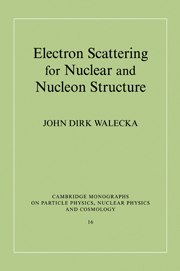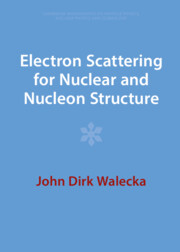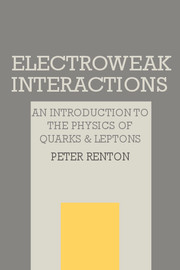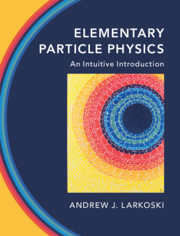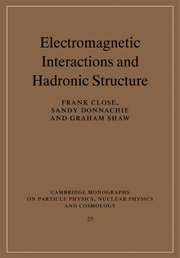Electron Scattering for Nuclear and Nucleon Structure
The scattering of high-energy electrons from nuclear and nucleon targets provides a microscope for examining the structure of these tiny objects. The best evidence we have on what nuclei and nucleons actually look like comes from electron scattering. This 2001 book examines the motivation for electron scattering and develops the theoretical analysis of the process. It discusses our current theoretical understanding of the underlying structure of nuclei and nucleons at appropriate levels of resolution and sophistication, and summarizes present experimental electron scattering capabilities. Only a working knowledge of quantum mechanics and special relativity is assumed, making this a suitable textbook for graduate and advanced undergraduate courses. It will also provide a valuable summary and reference for researchers already working in electron scattering and other areas of nuclear/particle physics.
- Covers current experimental capabilities and previews future directions
- Summarizes selected key experiments in the field and the insight gained from them
- Author is at the forefront of nuclear physics research
Reviews & endorsements
'Walecka is a leading nuclear theorist who has been strongly associated with electron scattering work at each of these world-class facilities, and he is undoubtedly uniquely qualified in this field … the present book is thus long-awaited masterly exposition of the field by its leading international proponent. In all respects this is an impressive and scholarly tome … it is hard to imagine this work being bettered in the near future, and it will surely now stand as the textbook in the field for many years to come. It deserves to be read by any serious student of the field.' R. F. Bishop, Contemporary Physics
Product details
November 2001Hardback
9780521780438
378 pages
254 × 178 × 22 mm
0.87kg
139 b/w illus. 9 tables
Temporarily unavailable - available from TBC
Table of Contents
- Part I. Introduction:
- 1. Motivation
- 2. Pictures of the nucleus
- 3. Some optics
- 4. Why electron scattering?
- 5. Target response surfaces
- 6. Why coincidence experiments?
- 7. Units and conventions
- Part II. General Analysis:
- 8. Electromagnetic interactions
- 9. Multipole analysis
- 10. Dirac equation
- 11. Covariant analysis
- 12. Excitation of discrete states in (e, e*)
- 13. Coincidence experiments (e, e* X)
- 14. Deep inelastic scattering from the nucleon
- 15. Polarization in deep inelastic scattering
- 16. Parity violation in inclusive electron scattering
- Part III. Quantum Electrodynamics:
- 17. Basic elements
- 18. Radiative corrections
- Part IV. Selected Examples:
- 19. Basic nuclear structure
- 20. Some applications
- 21. A relativistic model of the nucleus
- 22. Elastic scattering
- 23. Quasielastic scattering
- 24. The quark model
- 25. Quantum chromodynamics
- 26. The standard model
- 27. Parity violation
- 28. Excitation of nucleon resonances
- Part V. Future Directions:
- 29. TJNAF(CEBAF)
- 30. Other facilities
- 31. Future directions
- Appendixes.

